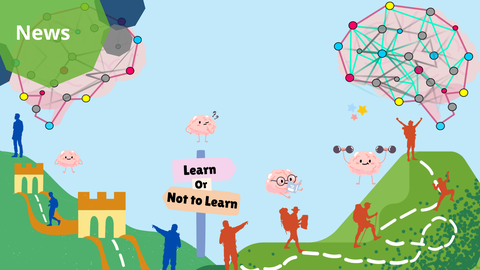Feb 17, 2025
Beyond Nature, Nurture, and Chance: How Individual Choices Shape Us and Our Brains

An artistic visualization of the study results. Mice that chose to engage in learning tasks took an off the beaten track that led to a higher neural connectivity in the brain. Mice that abstained from learning tasks took a comfortable road and had less complex neural connections. © Warsha Barde
An international team of researchers led by Prof. Gerd Kempermann at the Center for Regenerative Therapies (CRTD) and Deutsches Zentrum für Neurodegenerative Erkrankungen (DZNE) together with scientists led by Dr. Hayder Amin (DZNE) discovered a previously unrecognized mechanism for functional adaption of the adult brain. By studying mice, they found that behavioral choices lead to individualized learning profiles, accompanied by different neuronal networks and an increase in neurons. This work provides insights into how even identical twins raised in the same household often grow up to have distinct personalities. Their findings were published in the journal Science Advances.
The brain is the body’s most complex organ. It contains around 100 billion brain cells, known as neurons, which form an intricate network allowing us to form complex thoughts. Although most neurons are already present at birth, the connections between them, the synapses, retain the ability for structural and functional changes. This brain plasticity is directed by experiences and learning throughout life.
Through a process called neurogenesis, the brain can also grow new brain cells from neural stem cells. While this process is common in embryos, the adult brain can rarely grow new neurons. One of the places where formation of new neurons happens even in adults is the hippocampus. This brain structure is involved in learning and memory and can react to new stimuli by forming new neurons, allowing us to learn throughout our lives.
What exactly stimulates the adult brain to generate new neurons has been the subject of a long-reigning scientific debate. Now, scientists led by Prof. Kempermann explored a previously overlooked factor - individual choices.
Nature Versus Nurture
“Scientists debated whether brain development was determined by genes or environment,” says Prof. Gerd Kempermann, a research group leader at the CRTD and DZNE. “In this study, we looked beyond this ongoing debate of nature vs. nurture by introducing a third factor, the individual agency.”
Agency refers to person’s ability to act independently and make choices that influence their own experiences and outcomes. It is the driving force behind all personal choices. The Kempermann group investigated how much individual agency in the form of conscious learning efforts can actually influence brain development in adult mammals.
A Special Experimental Setup
The Kempermann group studied a group of genetically identical mice that lived in the same environment. The mice were provided with a variety of learning tasks. For every successfully completed task, the mice were rewarded with sweetened water as a positive reinforcement. If the task was not completed, there were no consequences. Such a setup guaranteed that the actions of the mice were driven only by their individual choices.
“We used an innovative and computer-monitored environment that allowed us to closely follow the behavior of individual mice. In this way, we could study how their individual learning behaviors shape their brains during the experiment,” explains Prof. Kempermann.
Over the course of multiple weeks, the team gradually increased the difficulty of the learning tasks. The adapted environment prompted the mice to consciously re-explore their habitat for new rewards.
“By observing their roaming habits and engagement with the learning tasks, we could then examine how well the mice adapted to their changed environment,” Prof. Kempermann adds.
The Influence of Individual Agency
Over time, the mice developed increasingly stable and unique patterns of exploration, learning, and brain plasticity. While some individuals quickly took up new challenges, others almost immediately stopped exploring their environment. Like in schools, the researchers could identify “best learners” and “worse learners” by their adaptability to ever-changing tasks and total number of completed tasks.
The Kempermann group collaborated with the Amin group to find out if brains of best learners and worse learners developed differently. To do that, they looked at the hippocampus, a brain structure involved in learning and memory. Using a cutting-edge multi-electrode array technology, they investigated the network connectivity of the hippocampus and uncovered that best learners had a better-connected network inside their brain.
“Our findings reveal that if mice chose to engage in learning tasks, eventually their brains had more new neurons and higher levels of brain connectivity,” says Prof. Kempermann. “This means their neurons had more connections with other neurons, and that allows the brain to transmit information more easily. For comparison, mice that did not choose to engage in learning tasks did not show such vast improvements. As all mice were genetically identical and housed in the same environment, it was only their own choices that influenced how many new neurons and neural connections were created in their brains.”
A Look Into the Future
“These findings emphasize that brain development – and by extension, personality and individuality – is not solely determined by genes or the environment. Instead, we found that brain development is also shaped by personal choices and experiences,” Prof. Kempermann adds.
This work provides insights into why siblings and even identical twins raised in the same household often grow up to be so different. The idea that personal choices directly influence the brain could impact how humans approach education, learning, and personal growth. This discovery further emphasizes just how essential life-long learning is for continuous brain development. It also provides hope for the future. By choosing to engage in learning, maybe we can shape just who we want our future selves to be.
Original Publication
Warsha Barde, Jonas Renner, Brett Emery, Shahrukh Khanzada1, Xin Hu, Alexander Garthe, Annette E. Rünker, Hayder Amin, Gerd Kemperman: Beyond nature, nurture, and chance: Individual agency shapes divergent learning biographies and brain connectome. Science Advances (January 2025)
Link: https://www.science.org/doi/10.1126/sciadv.ads7297
